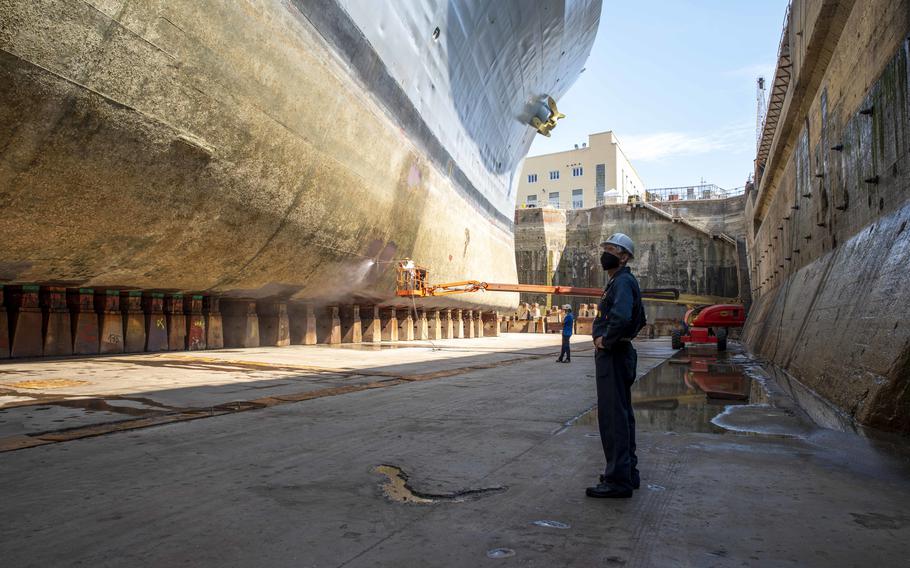
Command Master Chief Petty Officer Jeffrey M. West inspects USS Mount Whitney's hull at a dry dock in Genoa, Italy, July, 28, 2020. Mount Whitney, the U.S. 6th Fleet flagship, is slated to be decommissioned in 2026, according to Navy budget documents. (Scott Barnes/U.S. Navy)
A U.S. Navy ship that drew Russia’s ire, sailed multiple times in the Black Sea as a symbol of NATO strength and oversaw dozens of naval exercises is now on the chopping block.
USS Mount Whitney, the flagship of the Naples, Italy-based U.S. 6th Fleet and one of two Blue Ridge-class amphibious command-and-control ships in the Navy, is set to be decommissioned in 2026, according to the service’s 2023 budget.
The move would result in $179.7 million in savings, the Navy said in its 2023 budget highlights book.
The Navy didn’t go into detail about how it made the decision to decommission Mount Whitney. But in a section of the budget highlights book, the service said it was working to find “budgetary efficiencies.”
The Mount Whitney would be classified as out of commission in reserve and be kept on the Naval Vessel Register as a reactivation candidate, according to budget documents.
The other Blue Ridge-class ship, the USS Blue Ridge, is the flagship of U.S. 7th Fleet and is homeported in Yokosuka, Japan. It was commissioned in 1970.
Sebastian Bruns, McCain Fulbright scholar in residence at the U.S. Naval Academy and a maritime expert with the Center for Strategic and International Studies, said while modern communications would enable an ashore staff to handle commanding a task group, task force or exercise, the wider political and diplomatic purpose of a command ship can’t be as easily replaced.
“I have a difficult time imagining that rotational (destroyer) deployments into the European theater will alleviate the lack of a forward-present afloat platform that can deploy to allied countries in the region to send a signal of American naval presence,” Bruns said.
The USS Mount Whitney transits the Bosporus, entering the Black Sea near Istanbul, Nov. 4, 2021. (Yoruk Isik/Twitter)
Mount Whitney serves as the command ship for U.S. 6th Fleet, and Naval Striking and Support Forces NATO.
The ship currently is deployed to U.S. 5th Fleet, headquartered in Bahrain, as part of Combined Task Force 153, which focuses on the Red Sea, the Gulf of Aden and the connecting Bab el Mandeb waterway.
Commissioned in 1971, the Mount Whitney is homeported in Gaeta, Italy, near U.S. 6th Fleet headquarters. If decommissioned in 2026, the ship will have reached year 55 of an expected service life of 68 years, budget documents show.
In November 2021, the ship drew the attention of Russian President Vladimir Putin when it sailed in the Black Sea for routine NATO operations and port calls in Turkey, Georgia and Romania.
At the time, tensions were running high amid a buildup of more than 150,000 Russian troops near the borders of Ukraine, along with signs of impending aggression by Russian ships in the Black Sea. The Kremlin launched its full-scale invasion of Ukraine on Feb. 24.
At a November meeting with military leaders in Sochi, Putin used the ship’s presence as justification for bolstering the country’s air defense system.
In August 2008, the Mount Whitney was deployed to the Black Sea to deliver humanitarian aid during the war between Russia and Georgia.
In describing the Mount Whitney as his favorite ship in the Navy, Retired Adm. James G. Foggo III acknowledged tough decisions needed to be made “because there is not enough money to do all the things that the Navy needs to do to deter and defend in support of our national security interests.”
The Navy and Marine Corps need more funding to build ships and maintain older platforms such as Mount Whitney, he said.
“The ship is in great shape, and should the Navy continue to fund her readiness and modernization she can easily continue in active service throughout the decade of the 2030s,” said Foggo, who led U.S. Naval Forces Europe-Africa and Allied Joint Forces Command Naples from 2017 to 2020.